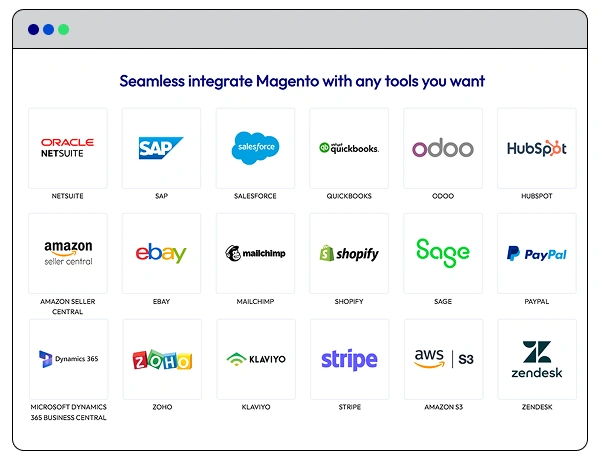Comparison of SAP systems for Magento integration
When integrating Magento with SAP, it’s crucial to choose the right SAP system based on your business size, processes, and scalability goals. Below is a comparison of the most commonly used SAP systems and how they align with Magento integration needs:
| SAP solution | Best for | Key features | Magento integration suitability |
|---|---|---|---|
| SAP Business One | Mid-sized businesses needing cloud ERP | Cloud-based ERP, modular design, built-in analytics | Scalable cloud integration for Magento |
| SAP Business ByDesign | Manual security measures | Automatic updates & SSL | Depends on plugins & hosting |
| SAP S/4HANA | Large enterprises with complex operations | Real-time data processing, AI-driven insights, multi-language, multi-currency | Enterprise-grade integration, suitable for B2B & B2C |
| SAP ECC (ERP Central Component) | Legacy SAP users | Core ERP suite covering finance, logistics, HR | Integration possible but may require more customization |
Custom or connector? The right way to integrate Magento with SAP?
Custom-built integration
-
Fully tailored to your business logic, workflows, and SAP configuration
-
Designed to match specific SAP versions (S/4HANA, ECC...) and Magento setups
-
Direct API integration, full control over data access, encryption, and error handling
-
Easily scaled with your business; future-proof for growth and changes
-
End-to-end logic built around your exact needs (pricing rules, B2B flows, approval levels...)
-
Full ownership with ability to debug, update, or expand integration logic
-
Higher upfront investment, but lower long-term costs and better ROI
Prebuilt connectors / extensions
-
Limited to standard use cases and predefined data structures
-
May not support all SAP modules or custom Magento themes
-
Often involves third-party middleware; less control over data flow
-
Scaling may break existing connectors; costly upgrades
-
Customization limited or requires heavy workaround
-
Dependent on connector vendor for updates and bug fixes
-
Lower initial cost, but ongoing license or support fees; risk of hidden costs
Key features of SAP-Magento integration
Mageplaza offers tailored Magento–SAP integration solutions built around your unique system architecture, business workflows, and scalability requirements. Below are some key features included in our service:

Real-time data sync
Data such as orders, inventory, customer info, and pricing is instantly synced between Magento and SAP. This ensures both systems always reflect the latest information, reducing errors and improving decision-making.

Automated order & inventory handling
Magento orders are automatically pushed to SAP for processing, invoicing, and fulfillment. Inventory changes in SAP update Magento in real time, helping avoid overselling and out-of-stock issues.

Financial integration
Invoices, payments, tax details, and credit memos flow smoothly between both platforms. This reduces manual reconciliation and ensures accurate, timely financial reporting.

Customer data consistency
Customer accounts, group pricing, purchase history, and B2B contract terms are shared across systems. This allows for consistent experiences, personalized pricing, and better account management.

Multi-store & localization support
Run multiple Magento stores in different regions with unified control via SAP. The integration supports multi-currency, multilingual content, and regional tax rules—ideal for global operations.

Workflow customization
Custom rules—like tiered pricing, order routing, or delivery terms—can be configured to match your unique processes. The integration flexibly adapts to how your business works.
Want to explore more Magento integrations?
Mageplaza empowers your Magento store with seamless integration to 40+ industry-leading business tools - ranging from CRMs, ERPs, and accounting software to eCommerce platforms and marketing solutions.
We tailor each solution to fit your unique operational needs - from startups to large enterprises. If you're unsure where to begin or need a custom solution, our expert team is here to consult and build a roadmap for your integration journey.
Why should you choose Mageplaza?
10+
years in technology
40+
dedicated developers
1500+
projects delivered
4.8
stars on Trustpilot
98%
customer satisfaction
24/7
support

Let's talk!
122,000 clients have been prospering with our services. It's your turn now!
- Free 1:1 consultation
- Free 2-month support after the project
- 10+ years of experience in E-commerce

Frequently asked questions (FAQs)
Magento can integrate with various SAP systems including SAP Business One, SAP Business ByDesign, SAP ECC, and SAP S/4HANA. The right choice depends on your business size, industry, and operational complexity.
Implementation time varies based on your system complexity, data volume, and customization needs. On average, standard integrations take 4–8 weeks, while more complex projects may take longer.
Some basic integrations can be handled with pre-built connectors or middleware. However, businesses with specific workflows, B2B pricing, or regional tax rules often require custom development for full alignment.
No, a well-planned integration is done in a staging environment first. Once thoroughly tested, it’s deployed to your live store with minimal disruption or downtime.

